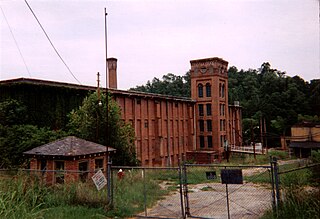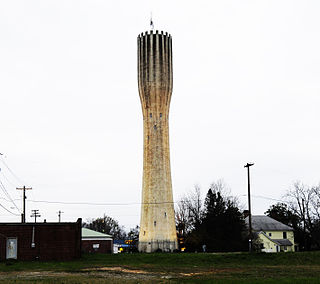
Anderson County is a county located in the U.S. state of South Carolina. As of the 2010 census, its population was 187,126. Its county seat is Anderson. Named for Revolutionary War leader Robert Anderson, the county is located in northwestern South Carolina, along the state line of Georgia. Anderson County is included in the Greenville-Anderson-Mauldin, SC Metropolitan Statistical Area. Anderson County contains 55,950-acre (226 km2) Lake Hartwell, a U.S. Army Corps of Engineers lake with nearly 1,000 miles (2,000 km) of shoreline for residential and recreational use. The area is a growing industrial, commercial and tourist center. It is the home of Anderson University, a private, selective comprehensive university of approximately 3,000 undergraduate and graduate students.

Belton is a city in eastern Anderson County, South Carolina, United States. The population was 4,134 at the 2010 census.

This is a list of sites in Minnesota which are included in the National Register of Historic Places. There are more than 1,700 properties and historic districts listed on the NRHP; each of Minnesota's 87 counties has at least 2 listings. Twenty-two sites are also National Historic Landmarks.

Stagville Plantation is located in Durham County, North Carolina. With buildings constructed from the late 18th century to the mid-19th century, Stagville was part of one of the largest plantation complexes in the American South. The entire complex was owned by the Bennehan, Mantack and Cameron families; it comprised roughly 30,000 acres (120 km2) and was home to almost 900 enslaved African Americans in 1860.

Borough House Plantation, also known as Borough House, Hillcrest Plantation and Anderson Place, is an historic plantation on South Carolina Highway 261, 0.8 miles (1.3 km) north of its intersection with U.S. Route 76/US Route 378 in Stateburg, in the High Hills of Santee near Sumter, South Carolina. A National Historic Landmark, the plantation is noted as the largest assemblage of high-style pisé structures in the United States. The main house and six buildings on the plantation were built using this technique, beginning in 1821. The plantation is also notable as the home of Confederate Army General Richard H. Anderson.

Newry is a census-designated place in Oconee County, South Carolina, United States. According to the 2010 United States Census, the population of the CDP was 172.

Anderson Downtown Historic District in Anderson, South Carolina, originally built in the late 19th century, is a historic district that was listed on the National Register of Historic Places in 1979.
Belton Standpipe may refer to:

The Marian Anderson House is a historic home located in the Southwest Center City neighborhood of Philadelphia, Pennsylvania. Built circa 1870 in the same neighborhood where opera singer and civil rights advocate Marian Anderson was born 27 years later, this two-story, brick rowhouse dwelling was designed in the Italianate style. Purchased by Anderson in 1924, the same year she became the first African-American concert artist to record spirituals for a major American recording company, she continued to reside here until 1943. The house is currently home to the Marian Anderson Museum and Historical Society.

The Belton Depot, located in Belton, Anderson County, South Carolina was constructed by the Southern Railway company around 1910 and was listed in the National Historic Register on August 13, 1979. Historically known as the Southern Railway Combined Depot, it replaced several small buildings used by the company.

The Belton Standpipe, in Belton, South Carolina, historically known as the Belton Waterworks Tower, is a 155-foot high concrete water tower located near the downtown area. Construction on the tower began in 1908 and was completed in 1909. It is the tallest of three standpipe water towers in the state.

The Boone-Douthit House is located on the outskirts of Pendleton, South Carolina. The house is an excellent example of how an “upstate” (western) South Carolina plantation house has been expanded as its occupant's needs changed over time, and/or as the occupants pursued other interests. In addition to the main home, the site also includes a large barn, a secondary house, a building that may have once served as a doctor's office, a small storage building, and another small building that may have been used for silkworm culture, all of which contribute to the site's historical significance. The house is thought to have been constructed around 1849.

The Ralph John Ramer House, is located near the downtown area of Anderson, South Carolina. The house was built in 1930 and is historically significant as an excellent example of an early-20th century Tudor Revival residence. Ramer was a leading Anderson businessman, government official, military officer and civic leader. Much of the noteworthy architectural detail of this house can be viewed from the public road that fronts the grounds. The house was listed in the National Register on February 10, 1992.

General Francis Marion Bamberg (1838-1905), the builder of the General Francis Marion Bamberg House, played an important role in the growth of the town and county of Bamberg, South Carolina. Among other accomplishments, General Bamberg promoted the educational, religious, economic and cultural growth of the town of Bamberg, gave a library and gymnasium to the Carlisle Fitting School, and significant sums for the construction of a Methodist church. The house, located in one of Bamberg's oldest residential areas, was listed in the National Register of Historic Places on June 29, 1976.
The McFall House was a residence in Anderson, South Carolina. Andrew McFall, a local farmer, constructed the house in 1825. The house was listed on the National Register of Historic Places in June 1982 and removed from the register on December 8, 2005. The McFall House was Anderson's oldest brick house.

Seaside Plantation House, also known as Locksley Hall, is a historic plantation house located at Edisto Island, Colleton County, South Carolina. It was built about 1810, and is a 2+1⁄2-story, Federal style brick dwelling with a gable roof. The house is one room deep with a long porch across the southeast elevation and sits on a raised basement. The central portion of the house is stuccoed brick with frame additions on the first floor.

Kincaid-Anderson House, also known as Fairfield, is a historic home located near Jenkinsville, Fairfield County, South Carolina. It was built about 1774, and is a two-story, brick Georgian style dwelling. It has a hipped roof and sits on a fieldstone foundation. It has small brick side wings that were added in a 1920s restoration. Also on the property is a two-story brick and frame work house that has been converted into a guesthouse. It was the home of James Kincaid, who was one of the first purchasers of cotton in the South Carolina upcountry and was possibly involved in the early development of a cotton gin.

Caldwell–Hampton–Boylston House is a historic home located at Columbia, South Carolina. It was built between 1820 and 1830, and is a three-story, five bay, clapboard clad frame dwelling in the Greek Revival style. It features a two-story, projecting front porch. Also on the property is contributing ironwork and brick fencing, and a stable/carriage house, garden gazebo, and tea house. In 1874–1876, it was the residence of South Carolina Reconstruction governor Daniel H. Chamberlain, who purchased the house in 1869.
Barnwell House, also known as Prospect Hill Plantation, is a historic home located at Adams Run, Charleston County, South Carolina. It consists of the front or main portion dating from 1878 and the rear section from early to mid-19th century. The main part is a 2+1⁄2-story building, with a stuccoed brick first story and weatherboarded upper story. The front façade features a one-story portico with a bell cast hip roof supported by two solid Doric order fluted columns. It was listed on the National Register of Historic Places in 1980.




















